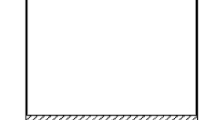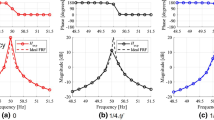Abstract
The present study aims to demonstrate the capabilities of singular spectrum analysis (SSA) as a filter bank that could potentially be integrated into a modal identification framework using single-sensor output information. SSA reconstructs the original time series using principal components from the signal subspace—thereby eliminating noise components altogether—and yields a filtered signal that finds its use in modal identification. Using time-domain decomposition and least-squares technique, the modal response generated using SSA is fit with a free-decay signal from which the estimates of natural frequencies and damping ratios are carried out. The paper attempts to investigate a simple model of a dynamical system and analyzes it using the proposed approach to provide a comparison with traditional operational modal analysis techniques. The results demonstrate that SSA can be used as a powerful tool for the analysis of vibratory behavior for structures exhibiting well-separated spectral components. Inherent filtering embedded within its framework and its seamless integration into a modal identification framework hold strong promise for application inbuilt infrastructure systems.
Access this chapter
Tax calculation will be finalised at checkout
Purchases are for personal use only
Similar content being viewed by others
References
Zhou W, Chelidze D (2007) Blind source separation based vibration mode identification. Mech Syst Signal Process 21(8):3072–3087
Hazra B, Sadhu A, Roffel AJ, Narasimhan S (2012) Hybrid time-frequency blind source separation towards ambient system identification of structures. Comput-Aided Civ Infrastruct Eng 27(5):314–332
Li J, Zhu X, Law SS, Samali B (2019) Drive-by blind modal identification with singular spectrum analysis. J Aerosp Eng 32(4):04019050
Bhowmik B, Krishnan M, Hazra B, Pakrashi V (2019) Real-time unified single-and multi-channel structural damage detection using recursive singular spectrum analysis. Struct Health Monit 18(2):563–589
Krishnan M, Bhowmik B, Hazra B, Pakrashi V (2018) Real time damage detection using recursive principal components and time varying auto-regressive modeling. Mech Syst Signal Process 101:549–574
Bhowmik B (2018) Online structural damage detection using first order Eigen perturbation techniques. Doctoral Dissertation
Bhowmik B, Tripura T, Hazra B, Pakrashi V (2019) First-order Eigen-perturbation techniques for real-time damage detection of vibrating systems: theory and applications. Appl Mech Rev 71(6)
Yang Y, Nagarajaiah S (2013) Time-frequency blind source separation using independent component analysis for output-only modal identification of highly damped structures. J Struct Eng 139(10):1780–1793
Bhowmik B, Tripura T, Hazra B, Pakrashi V (2020) Real time structural modal identification using recursive canonical correlation analysis and application towards online structural damage detection. J Sound Vib 468:115101
Bhowmik B, Tripura T, Hazra B, Pakrashi V (2020) Robust linear and nonlinear structural damage detection using recursive canonical correlation analysis. Mech Syst Signal Process 136:106499
Sadhu A, Hazra B, Narasimhan S (2013) Decentralized modal identification of structures using parallel factor decomposition and sparse blind source separation. Mech Syst Signal Process 41(1–2):396–419
Zhang L, Brincker R (2005) An overview of operational modal analysis: major development and issues. In: Proceedings of the 1st International operational modal analysis conference, April 26–27, 2005, Copenhagen, Denmark. Aalborg Universitet, pp 179–190
Brincker R, Zhang L, Andersen P (2001) Modal identification of output-only systems using frequency domain decomposition. Smart Mater Struct 10(3):441
Peeters B, De Roeck G (1999) Reference-based stochastic subspace identification for output-only modal analysis. Mech Syst Signal Process 13(6):855–878
Kim BH, Stubbs N, Park T (2005) A new method to extract modal parameters using output-only responses. J Sound Vib 282(1–2):215–230
Cheynet E, Daniotti N, Jakobsen JB, Snæbjörnsson J (2020) Improved long‐span bridge modeling using data‐driven identification of vehicle‐induced vibrations. Struct Control Health Monit 27(9):e2574
Bhowmik B, Panda S, Hazra B, Pakrashi V (2021) Feedback-driven error-corrected single-sensor analytics for real-time condition monitoring. Int J Mech Sci 106898
Author information
Authors and Affiliations
Corresponding author
Editor information
Editors and Affiliations
Rights and permissions
Copyright information
© 2023 The Author(s), under exclusive license to Springer Nature Singapore Pte Ltd.
About this paper
Cite this paper
Bhowmik, B. (2023). Improved Single-Sensor-Based Modal Identification Using Singular Spectrum Analysis. In: Nandagiri, L., Narasimhan, M.C., Marathe, S. (eds) Recent Advances in Civil Engineering. CTCS 2021. Lecture Notes in Civil Engineering, vol 256. Springer, Singapore. https://doi.org/10.1007/978-981-19-1862-9_56
Download citation
DOI: https://doi.org/10.1007/978-981-19-1862-9_56
Published:
Publisher Name: Springer, Singapore
Print ISBN: 978-981-19-1861-2
Online ISBN: 978-981-19-1862-9
eBook Packages: EngineeringEngineering (R0)




